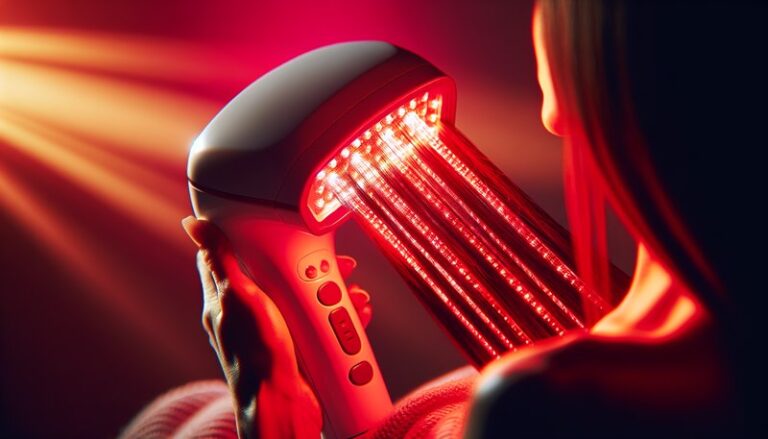Will Red Light Therapy Fade Tattoos?
Will Red Light Therapy Fade Tattoos?
Have you ever wondered if modern treatments can help fade that tattoo you’ve grown tired of? Red light therapy has become increasingly popular for various skin treatments, but can it effectively reduce the appearance of tattoos? In this article, we’ll explore the potential of red light therapy as a solution for tattoo fading, its benefits, considerations, and alternative options.
Key Takeaways
- Red light therapy works by promoting skin healing and may aid in the fading of tattoos over time.
- While red light therapy is beneficial for other skin conditions, its effectiveness on tattoos specifically is still under research.
- There are various alternatives to consider if you want to remove or fade a tattoo more rapidly.
What is Red Light Therapy?
Red light therapy, also known as low-level laser therapy (LLLT), involves the use of red wavelengths of light to promote healing and rejuvenation of the skin. This treatment is often used to address conditions such as acne, wrinkles, and scars, stemming from its ability to stimulate cellular activity and improve circulation.
How Does it Work?
The red and near-infrared light penetrates the skin, stimulating the mitochondria in cells. This process increases ATP (adenosine triphosphate) production, boosting energy levels in cells, which can enhance the skin’s natural healing capabilities. This response is what some believe might contribute to fading tattoos over an extended period.
What are the Benefits of Red Light Therapy?
Red light therapy has a variety of potential benefits that may not only enhance overall skin health but also help with tattoo fading. Let’s explore.
Skin Healing and Remodeling
One of the main advantages of red light therapy is its ability to promote skin healing. It encourages collagen production, which can help with the skin’s overall structure, potentially allowing tattoos to fade more naturally as the skin rejuvenates.
Reduced Inflammation
Red light therapy can reduce inflammation, which may contribute to keeping the skin healthier during the fading process. A healthier skin layer can aid in the gradual breakdown of tattoo ink particles, although this is still a developing area of study.
Pain Relief
For some patients undergoing tattoo fading treatments, pain and discomfort can be an issue. Red light therapy is known to provide some level of pain relief, making it a supportive option alongside other tattoo removal methods.
See our post on Does Red Light Therapy Reduce Wrinkles?
Enhanced Blood Flow
This therapy increases blood circulation in the treated area, which may help to flush out tattoo ink more effectively. Improved nutrient delivery to the skin can also support overall skin health, contributing to the fading process.
Dive deeper into Is Red Light Therapy Like Laser Therapy?
Is it Possible to Fade Tattoos with Red Light Therapy?
While red light therapy has promising benefits, the specific effectiveness for tattoo fading is still under significant debate. Current studies suggest that while the therapy can support skin health, more robust methods, like laser tattoo removal, might be necessary for substantial fading.
What are the Advantages of Using Red Light Therapy for Fading Tattoos?
Exploring the potential benefits, some advantages of using red light therapy include:
- Non-invasive treatment option, which is less intimidating than surgical methods.
- Minimal side effects compared to more aggressive tattoo removal techniques.
- Can be used alongside other treatments to enhance results.
What are the Disadvantages of Using Red Light Therapy for Fading Tattoos?
However, there are also challenges associated with this method:
- Limited scientific evidence proving its effectiveness for tattoo removal.
- Results are typically less dramatic and require multiple sessions.
- May not work for all skin types or tattoo inks.
What are the Things to Consider Before Trying Red Light Therapy for Tattoos?
Before considering red light therapy as a method for fading tattoos, it’s important to evaluate several factors.
Skin Type and Tattoo Ink
Different skin types may react differently to red light therapy, and tattoo inks can also affect results. Conducting patch tests and consulting with a professional can provide insight into personal suitability.
Treatment Frequency and Commitment
Achieving noticeable results may require consistent treatment over several weeks or months. It’s critical to commit to a regimen to observe any potential fading effects.
Consultation with a Professional
Before beginning any treatment, consulting with a qualified professional will help set realistic expectations and identify the most effective approach for your unique situation.
What are the Alternatives to Red Light Therapy for Fading Tattoos?
If considering other options, several alternatives exist aside from red light therapy.
Laser Tattoo Removal
Laser removal is a well-researched and commonly used option that breaks down tattoo ink into smaller particles, allowing the body to absorb them more easily. While it can be more painful and costly, it often provides quicker results than light therapy.
Tattoo Fading Creams
There are topical creams designed to lighten tattoos. Although results can vary widely depending on the ink used and skin type, these creams offer a less invasive alternative.
Microneedling
Microneedling involves creating tiny wounds in the skin to promote collagen production and potentially help fade tattoos. It’s important to note that multiple sessions may be required.
Conclusion: Is it Recommended to Use Red Light Therapy for Fading Tattoos?
While red light therapy may have benefits for skin health and healing, its effectiveness specifically for tattoo fading is not yet fully established. If you’re considering this option, weigh the pros and cons and consult a professional to explore the best strategies for your needs.
Frequently Asked Questions
Can red light therapy completely remove a tattoo?
No, red light therapy is unlikely to completely remove a tattoo. It may help in fading the tattoo over time, but results will vary and more intensive methods may be needed for complete removal.
How long do I need to undergo red light therapy to see results on a tattoo?
Results can depend on various factors including skin type and tattoo specifics. It typically requires several sessions over weeks or months to notice significant fading.
Are there any side effects associated with red light therapy?
Generally, red light therapy is considered safe with minimal side effects, though some individuals may experience mild redness or irritation after treatment.
Is red light therapy suitable for all skin types?
While red light therapy is safe for most skin types, a patch test is advisable—consult with a professional to ensure it’s appropriate for you.
What other methods can I consider for fading tattoos?
Besides red light therapy, options include laser removal, fading creams, and microneedling. It’s essential to research each method and consult with a qualified professional before proceeding.





